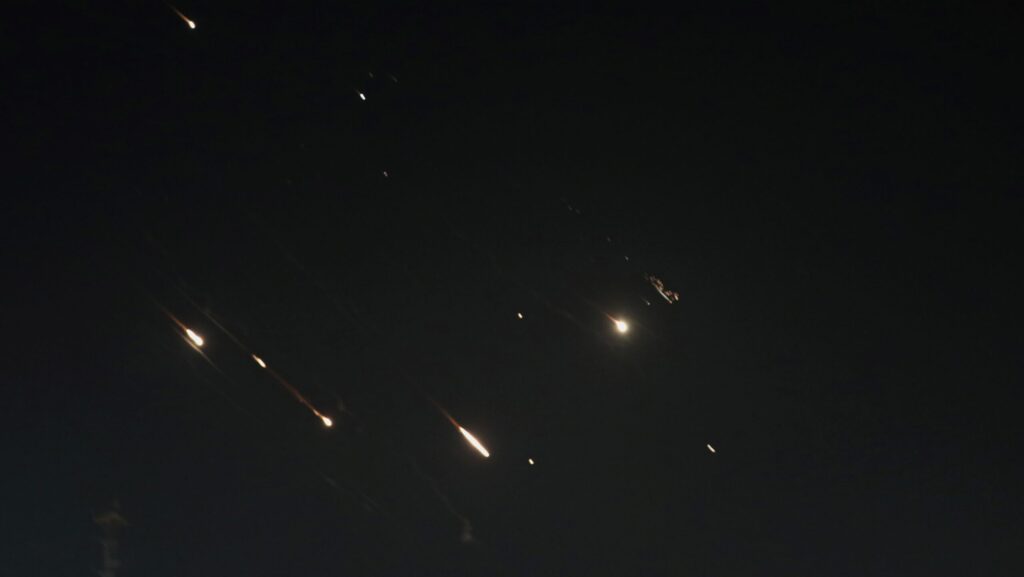This photo taken on April 14, 2024 shows flares from explosions in the sky over Jerusalem as Israel’s Iron Dome anti-missile system intercepts missiles and drones from Iran. (Photo by Jamal Awad/Xinhua via Getty Images)
JERUSALEM — Years of training, testing and joint exercises with the US helped Israel prepare its defenses for threats it has faced over the last nine months — not only relative short strikes from Hamas in Gaza, but long-range drone and missile attacks from the Houthis in Yemen and from Iran, according to a senior Israeli defense official.
“Whatever we simulated and tested over so many years, has proven itself,” Moshe Patel, the director of the Israeli Missile Defense Organization (IMDO), told an audience at the Center for Strategic and International Studies on Friday, specifically referring to Israel’s defense in a mass Iranian attack in April. Overall, he said, “I think that the lesson learned from what happened during the war, and the preparations, how we can be much better, will continue to be shared and we are very glad to have family like [the US].”
Patel highlighted Israel’s success at several key dates in the most recent conflict, starting at its outset on Oct. 7 during Hamas’s initial, devastating terrorist attack. Israel Defense Forces (IDF) may have been overrun on the ground, but Patel said its air defenses worked well in defending against thousands of rocket attacks from Gaza that day.
“We had a massive attack on Israel and all of our architecture worked very good,” he said. Though Israel lost hundreds of soldiers and more than 1,000 civilians were killed in the attack on the ground, Patel said air defenses saved thousands more lives.
Israeli air defenses got their next test the next day, when Hezbollah entered the conflict, firing munitions from Lebanon in the north — 5,000 such munitions as of mid-June. The triple-layered air defense has been successful in stopping most Hezbollah missiles, rockets and drones, but Patel said some do slip through and, alongside anti-tank missiles, can pose a threat to Israelis in the border with Lebanon.
Perhaps the most significant test of Israeli systems came on April 13, when Iran fired an unprecedented approximately 300 missiles and drones at Israel, while others are believed to have been fired from Hezbollah and other Iran-backed proxy groups — totaling 550 projectile threats, according to Patel. Though Tehran did give neighboring countries warning, Patel said, “From the Iranian point of view it was planned excellently.” He noted the attack was coordinated so that Iranian drones, cruise missiles and ballistic missiles would arrive over Israel at the same time to try to overwhelms Israel’s systems.
Many of the slow-moving drones were taken out by warplanes before they could reach their targets, and Israel was able to lean on the US, UK and even Jordan, to take out others. Still, Israel intercepted many of the ballistic missiles. In the end, one seven-year old girl severely wounded by debris from an interception and there was relatively little damage to an Israeli military air field. No lives were lost.
The successful defense against that attack, Patel said, was in part due to close training with the US, including the joint air defense drill known as Juniper Cobra that took place just two weeks before the Oct. 7 attacks.
“What we were doing was preparing our operators, we have excellent dialogues with our US partners,” he said. Patel pointed to previous tests of Arrow 3, the top layer of Israel’s air defense system, in Alaska that helped pave the way for the real-life interceptions that took place in April and, before that, the Arrow 3’s first-ever operational exo-atmospheric interception of a Houthi missile on Nov. 9.
Patel described close cooperation with the US Missile Defense Agency, and said he spoke with the agency from the first day of the war to debrief and share information and discuss what could be done better. Patel also noted that Israel’s shift to being under US Central Command’s area of responsibility, rather then European Command as it had been for decades, has led to increased interoperability and more joint training.
But, he said, Israel is not resting on its laurel in its successful defense so far. He discussed expediting the production process for the air defenses, and noted that Israel recently sold the lower level of the air defense system, David’s Sling, to Finland and Arrow to Germany. Even with the recent war, he said Israel would fulfill those deals as expected.











